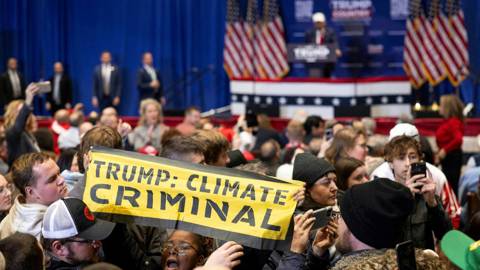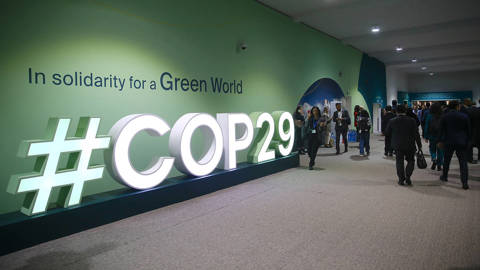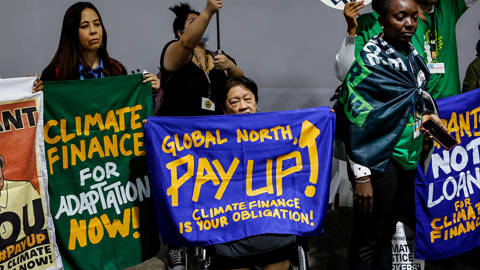Underlying the failure of the climate change summit in Copenhagen last month is the failure of the idea that carbon-emission rights can be allocated fairly. Perhaps it is time to try another approach: a commitment by each country to raise the price of emissions (whether through a carbon tax or emissions caps) to an agreed level, say, $80 per ton.
NEW YORK – Pretty speeches can take you only so far. A month after the Copenhagen climate conference, it is clear that the world’s leaders were unable to translate rhetoric about global warming into action.
It was, of course, nice that world leaders could agree that it would be bad to risk the devastation that could be wrought by an increase in global temperatures of more than two degrees Celsius. At least they paid some attention to the mounting scientific evidence. And certain principles set out in the 1992 Rio Framework Convention, including “common but differentiated responsibilities and respective capabilities,” were affirmed. So, too, was the developed countries’ agreement to “provide adequate, predictable and sustainable financial resources, technology, and capacity-building….” to developing countries.
The failure of Copenhagen was not the absence of a legally binding agreement. The real failure was that there was no agreement about how to achieve the lofty goal of saving the planet, no agreement about reductions in carbon emissions, no agreement on how to share the burden, and no agreement on help for developing countries. Even the commitment of the accord to provide amounts approaching $30 billion for the period 2010-2012 for adaptation and mitigation appears paltry next to the hundreds of billions of dollars that have been doled out to the banks in the bailouts of 2008-2009. If we can afford that much to save banks, we can afford something more to save the planet.
The consequences of the failure are already apparent: the price of emission rights in the European Union Emission Trading System has fallen, which means that firms will have less incentive to reduce emissions now and less incentive to invest in innovations that will reduce emissions in the future. Firms that wanted to do the right thing, to spend the money to reduce their emissions, now worry that doing so would put them at a competitive disadvantage as others continue to emit without restraint. European firms will continue to be at a competitive disadvantage relative to American firms, which bear no cost for their emissions.
Underlying the failure in Copenhagen are some deep problems. The Kyoto approach allocated emission rights, which are a valuable asset. If emissions were appropriately restricted, the value of emission rights would be a couple trillion dollars a year – no wonder that there is a squabble over who should get them.
Clearly, the idea that those who emitted more in the past should get more emission rights for the future is unacceptable. The “minimally” fair allocation to the developing countries requires equal emission rights per capita. Most ethical principles would suggest that, if one is distributing what amounts to “money” around the world, one should give more (per capita) to the poor.
So, too, most ethical principles would suggest that those that have polluted more in the past – especially after the problem was recognized in 1992 – should have less right to pollute in the future. But such an allocation would implicitly transfer hundreds of billions of dollars from rich to poor. Given the difficulty of coming up with even $10 billion a year – let alone the $200 billion a year that is needed for mitigation and adaptation – it is wishful thinking to expect an agreement along these lines.
Perhaps it is time to try another approach: a commitment by each country to raise the price of emissions (whether through a carbon tax or emissions caps) to an agreed level, say, $80 per ton. Countries could use the revenues as an alternative to other taxes – it makes much more sense to tax bad things than good things. Developed countries could use some of the revenues generated to fulfill their obligations to help the developing countries in terms of adaptation and to compensate them for maintaining forests, which provide a global public good through carbon sequestration.
We have seen that goodwill alone can get us only so far. We must now conjoin self-interest with good intentions, especially because leaders in some countries (particularly the United States) seem afraid of competition from emerging markets even without any advantage they might receive from not having to pay for carbon emissions . A system of border taxes – imposed on imports from countries where firms do not have to pay appropriately for carbon emissions – would level the playing field and provide economic and political incentives for countries to adopt a carbon tax or emission caps. That, in turn, would provide economic incentives for firms to reduce their emissions.
Time is of the essence. While the world dawdles, greenhouse gases are building up in the atmosphere, and the likelihood that the world will meet even the agreed-upon target of limiting global warming to two degrees Celsius is diminishing. We have given the Kyoto approach, based on emission rights, more than a fair chance. Given the fundamental problems underlying it, Copenhagen’s failure should not be a surprise. At the very least, it is worth giving the alternative a chance.









NEW YORK – Pretty speeches can take you only so far. A month after the Copenhagen climate conference, it is clear that the world’s leaders were unable to translate rhetoric about global warming into action.
It was, of course, nice that world leaders could agree that it would be bad to risk the devastation that could be wrought by an increase in global temperatures of more than two degrees Celsius. At least they paid some attention to the mounting scientific evidence. And certain principles set out in the 1992 Rio Framework Convention, including “common but differentiated responsibilities and respective capabilities,” were affirmed. So, too, was the developed countries’ agreement to “provide adequate, predictable and sustainable financial resources, technology, and capacity-building….” to developing countries.
The failure of Copenhagen was not the absence of a legally binding agreement. The real failure was that there was no agreement about how to achieve the lofty goal of saving the planet, no agreement about reductions in carbon emissions, no agreement on how to share the burden, and no agreement on help for developing countries. Even the commitment of the accord to provide amounts approaching $30 billion for the period 2010-2012 for adaptation and mitigation appears paltry next to the hundreds of billions of dollars that have been doled out to the banks in the bailouts of 2008-2009. If we can afford that much to save banks, we can afford something more to save the planet.
The consequences of the failure are already apparent: the price of emission rights in the European Union Emission Trading System has fallen, which means that firms will have less incentive to reduce emissions now and less incentive to invest in innovations that will reduce emissions in the future. Firms that wanted to do the right thing, to spend the money to reduce their emissions, now worry that doing so would put them at a competitive disadvantage as others continue to emit without restraint. European firms will continue to be at a competitive disadvantage relative to American firms, which bear no cost for their emissions.
Underlying the failure in Copenhagen are some deep problems. The Kyoto approach allocated emission rights, which are a valuable asset. If emissions were appropriately restricted, the value of emission rights would be a couple trillion dollars a year – no wonder that there is a squabble over who should get them.
Clearly, the idea that those who emitted more in the past should get more emission rights for the future is unacceptable. The “minimally” fair allocation to the developing countries requires equal emission rights per capita. Most ethical principles would suggest that, if one is distributing what amounts to “money” around the world, one should give more (per capita) to the poor.
BLACK FRIDAY SALE: Subscribe for as little as $34.99
Subscribe now to gain access to insights and analyses from the world’s leading thinkers – starting at just $34.99 for your first year.
Subscribe Now
So, too, most ethical principles would suggest that those that have polluted more in the past – especially after the problem was recognized in 1992 – should have less right to pollute in the future. But such an allocation would implicitly transfer hundreds of billions of dollars from rich to poor. Given the difficulty of coming up with even $10 billion a year – let alone the $200 billion a year that is needed for mitigation and adaptation – it is wishful thinking to expect an agreement along these lines.
Perhaps it is time to try another approach: a commitment by each country to raise the price of emissions (whether through a carbon tax or emissions caps) to an agreed level, say, $80 per ton. Countries could use the revenues as an alternative to other taxes – it makes much more sense to tax bad things than good things. Developed countries could use some of the revenues generated to fulfill their obligations to help the developing countries in terms of adaptation and to compensate them for maintaining forests, which provide a global public good through carbon sequestration.
We have seen that goodwill alone can get us only so far. We must now conjoin self-interest with good intentions, especially because leaders in some countries (particularly the United States) seem afraid of competition from emerging markets even without any advantage they might receive from not having to pay for carbon emissions . A system of border taxes – imposed on imports from countries where firms do not have to pay appropriately for carbon emissions – would level the playing field and provide economic and political incentives for countries to adopt a carbon tax or emission caps. That, in turn, would provide economic incentives for firms to reduce their emissions.
Time is of the essence. While the world dawdles, greenhouse gases are building up in the atmosphere, and the likelihood that the world will meet even the agreed-upon target of limiting global warming to two degrees Celsius is diminishing. We have given the Kyoto approach, based on emission rights, more than a fair chance. Given the fundamental problems underlying it, Copenhagen’s failure should not be a surprise. At the very least, it is worth giving the alternative a chance.